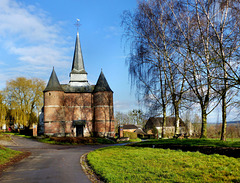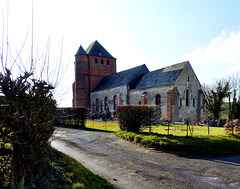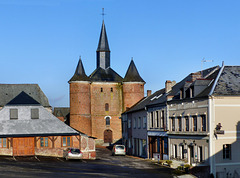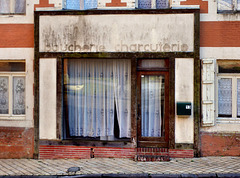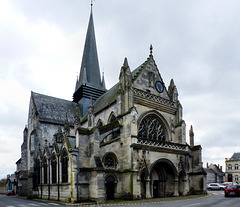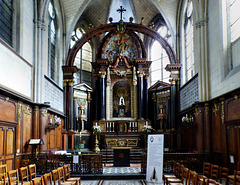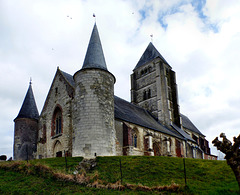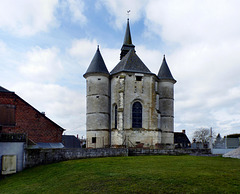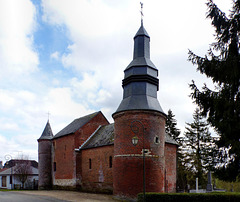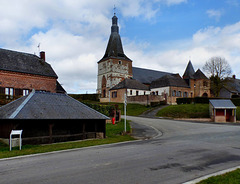
Picardy / Picardie
A collection of photos taken over the years. They just all have in common, that they were taken in Picardy (departements Aisne (02), Oise (60) and Somme (80)), that now is part of Hauts-de-France.
Gronard - Saint-Théodulphe
| |
|
|
|
Legends tell, that Saint-Théodulphe (aka "Saint Thiou") lived here as a hermit in the 6th century. At that time, there was no village here.
When the fortification of the church Saint-Théodulphe was undertaken in the 16th century, the village of Gronard must have had some importance - and probably a larger population. Today less than 100 people life here.
The Thiérache area in Northern France has been a place, where many wars and battles were fought over the centuries (upto WW1). To fortify the church, and so to offer shelter to the rural population, was an idea many villagers followed here.
Prisces - Saint-Médard
| |
|
The church, dedicated to Saint-Médard, dates to the 12th century and has some nicely sculpted Romanesque corbels. The huge donjon-like tower, built out of bricks, was added in the 16th century.
The Thiérache area in Northern France has been a place, where many wars and battles were fought over the centuries (upto WW1). To fortify the church, and so to offer shelter to the rural population, was an idea many villagers followed here.
Prisces - Saint-Médard
| |
|
|
The church, dedicated to Saint-Médard, dates to the 12th century and has some nicely sculpted Romanesque corbels. The huge donjon-like tower, built out of bricks, was added in the 16th century. The tower is massive, 25 metres high - and "dwarfs" the approaching visitor, this effect may have frighten mercenaries away, that roamed the area in search for any easy prey, - inbetween paid jobs.
Plomion - Notre-Dame
| |
|
The fortified church of Plomion was built entirely of brick on the foundations of an older church. There are about 60 loopholes all around the tower, that has a geometric pattern, created by glazed bricks.
The Thiérache area in Northern France has been a place, where many wars and battles were fought over the centuries (upto WW1). To fortify the church, and so to offer shelter to the rural population, was an idea many villagers followed here.
Plomion - Boucherie Charcuterie
| |
|
|
|
Behind every given up shop is a tragedy. Rural exodus is a big problem for small villages. German discounters Lidl and Aldi have opened about 2500 supermarkets in France since 1988. There is just no future..
Liesse-Notre-Dame - Basilique Notre-Dame
| |
|
Since the 12th century Liesse hosted a statue of a "Black Virgin", known as "Notre Dame de Liesse, source et cause de notre joie", and ever since then Liesse has been a center of Marian pilgrimage. Liesse was even a favorite destination for royal pilgrimages, visited by Louis VII, Charles VI, Charles VII and others.
The basilica was built during the late 13th and early 14th centuries and probably replaced an earlier chapel. It was probably erected with stones left over from the construction of the nearby Laon Cathedral. The portal and façade were constructed in the 15th century
In 1568 the troops of the Protesant Prince of Orange looted Liesse and the basilica village. The soldiers broke the statue, removed the bells and set fire to the church. The restoration was completed in 1577.
Liesse-Notre-Dame - Basilique Notre-Dame
| |
|
|
Since the 12th century Liesse hosted a statue of a "Black Virgin", known as "Notre Dame de Liesse, source et cause de notre joie", and ever since then Liesse has been a center of Marian pilgrimage. Liesse was even a favorite destination for royal pilgrimages, visited by Louis VII, Charles VI, Charles VII and others.
The basilica was built during the late 13th and early 14th centuries and probably replaced an earlier chapel. It was probably erected with stones left over from the construction of the nearby Laon Cathedral. The portal and façade were constructed in the 15th century
The statue is seen in the center. A legend tells, that it has been brought to Liesse by three Knights Hospitaller, named Jean, Hector, and Henri. During the Cruisade they were captured and taken to the Sultan of Egypt. The knights refused to convert to Islam despite promises of gold and honor. Angels brought the three imprisoned knights a small statue of Our Lady for consolation. The Sultan decided to send his daughter to the dungeon to convert the prisoners, but having learned about the Christian god she assisted in the knights´ escape. During the flight they fall asleep, and during their sleep were miraculously transported to Northern France. They woke up close to the Eppes´ castle in Picardy, where they came from. The Sultan´s daughter Ismeria, who had accompanied them, was baptised in the cathedral of Laon. The knights preserved the statue of the Madonna, and built a church to receive Our Lady of Liesse. That´s the legend "behind" the Black Virgin.
Chaourse - Saint-Martin
| |
|
|
The village of Chaourse is known as the place, where in 1883 the "Chaorse Treasure" was found, a hoard of Roman silver from the 2nd and 3rd century and one of the most complete table services from antiquity still existing. Engravings tell, that it was once owned by "Genialis" and Cavarianus". But as the treasure was sold in 1893 it is meanwhile owned by the British Museum.
The treasure is gone, but fortified Saint Martin, dating to the 13th century is still in the center of the village. A royal edict from 1365 allowed the population to erect a protective wall around the church, what started the fortification od the church.
Chaourse - Saint-Martin
| |
|
|
The village of Chaourse is known as the place, where in 1883 the "Chaourse Treasure" was found, a hoard of Roman silver from the 2nd and 3rd century, now in the British Museum. When the treasure was buried, the settlement´s name was "Catusiacum".
About thousand years later, when the church was burnt down during the Hundred Year´s War in 1337, the name had changed to "Chaorsia".
A royal edict from 1365 allowed the population to erect a protective wall around the church, what started the fortification of the church.
This baptismal font is dated to the 2nd quarter of the 12th century, so it is older then the church. It looks like a the font in Beaurain, a (simplified) copy of the font in the Cathedral of Leon.
Renneval - Notre Dame
| |
|
The high rising, fortified choir of Notre Dame in Renneval, built from white stones, probably had smaller windows, when it got erected. The flanking towers have lots of arrow slits. The rooms providing shelter for the refugees were in the upper floor of the choir.
Bancigny - Saint-Nicolas
| |
|
|
|
The perfect balance, Saint-Nicolas once had, is gone. During renovations, undertaken in the early 20th century, the top of the right tower was taken down - and got never replaced.
Jeantes - Saint-Martin
| |
|
|
A church in Jeantes was known since the 12th century, as it got mentioned in a charter of the Bishop of Laon Barthélémy. The building seen today was built from bricks around 1620-30 and probably replaced the older one.
Jeantes - Saint-Martin
| |
|
A church in Jeantes was known since the 12th century, as it got mentioned in a charter of the Bishop of Laon Barthélémy. The building seen today was built from bricks around 1620-30 and probably replaced the older one.
The interior of the church is surprising. In 1962 the Dutch artist Charles Eyck created great frescoes, covering 200 m² of the interior walls.
Jeantes - Saint-Martin
| |
|
A church in Jeantes was known since the 12th century, as it got mentioned in a charter of the Bishop of Laon Barthélémy. The building seen today was built from bricks around 1620-30 and probably replaced the older one.
The interior of the church is surprising. In 1962 the Dutch artist Charles Eyck created great frescoes, covering 200 m² of the interior walls.
Jeantes - Saint-Martin
| |
|
|
A church in Jeantes was known since the 12th century, as it got mentioned in a charter of the Bishop of Laon Barthélémy. The building seen today was built from bricks around 1620-30 and probably replaced the older one.
The interior of the church is surprising, as in 1962 the Dutch artist Charles Eyck created great frescoes, covering 200 m² of the interior walls.
This baptismal font was probably part of the 12th century church. Rectangular fonts, carved from bluestone ("Pierre bleue de Tournai") must have been very popular and the state of the art in Northern France within the 12th century.
Cuiry-lès-Iviers - Saint-Martin
| |
|
|
The fortified church, dedicated to Saint.Martin, was built from bricks in the 16th and 17th century. One of the flanking towers got a spire later, to house the church bells.
Dohis - Nativité-de-la-Sainte-Vierge
| |
|
|
|
The fortified church, located on a little hill in Dohis, is surrounded by a protective wall and only accesseble through a gate (seen behind the bus shelter). The church was erected within the 13th century, but the strong fortification of the whole complex is younger. To the left the old washhouse.
Parfondeval - Saint-Médard
| |
|
|
Parfondal, a village with a population of around 150, is one of the "Plus Beaux Villages de France". It is indeed pretty - and has the best documented fortified churches I visited in the Picardie. Saint-Médard, erected almost entirely of bricks, was built in the 16th century, and got enlarged in 1760.
It was once surrounded by a wall and a ditch. It was only accessable through the gate seen here. The church (incl. the tower and the rooms for the refugees) can be visited and there are even informative videos, explaining how people lived up there over longer periods.
Jump to top
RSS feed- Latest items - Subscribe to the latest items added to this album
- ipernity © 2007-2024
- Help & Contact
|
Club news
|
About ipernity
|
History |
ipernity Club & Prices |
Guide of good conduct
Donate | Group guidelines | Privacy policy | Terms of use | Statutes | In memoria -
Facebook
Twitter

